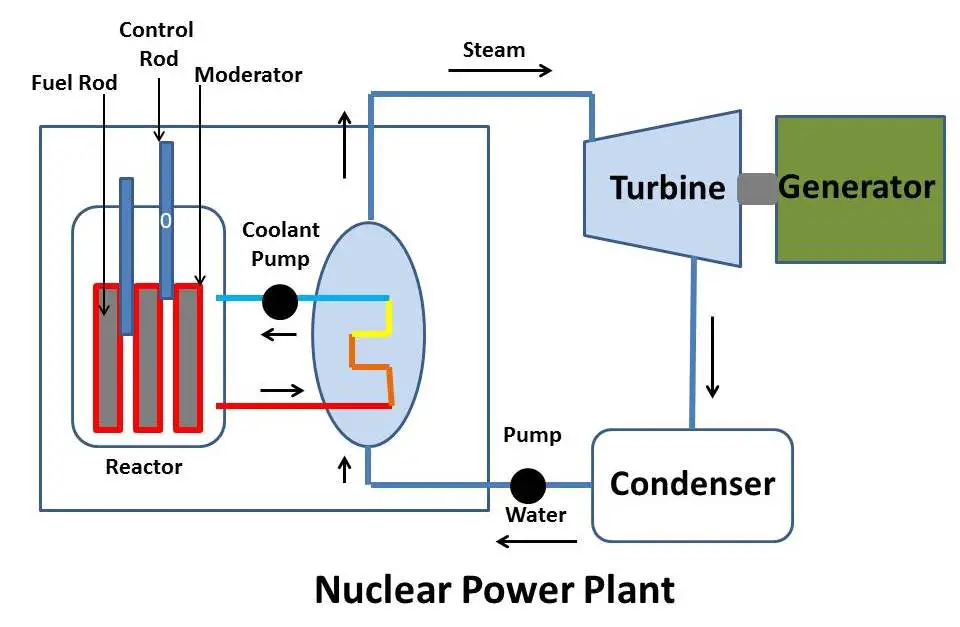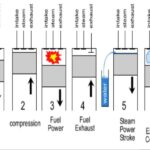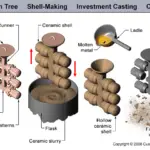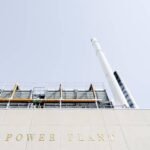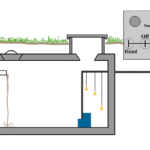As we all heard about different types of power plants which are used for power generation by using different kinds of fuels like steam power plant, hydro power plant etc. like all of these power plants one type of power plant which is developing very fast is known as Nuclear power plant. Nuclear power plant has same applications like other power plants i.e. to generate electricity but the major difference in the type of fuel used. Here we use radioactive fuel like uranium. Nuclear reactor is the heat source of nuclear power plant. This heat is used to generate steam which runs the turbine.
These days when the price of the fossil fuel is increasing at very high rate and due to their limited stock nuclear power plant is an economic necessity. The cost of generating electricity by using nuclear power plant is less as compare to the thermal power plant where coal is used as fuel. But nuclear industry have some draw backs due to its safety issue that’s why this is not consider as major power plant till date. India has only 3% contribution of nuclear power plant in total electricity generation. The energy released by the nuclear reaction is very large as compare to the chemical reaction. The heat released by one kg of uranium is equal to the combustion of 1,13,000 quintals of coal.
Components of nuclear power plant:
Nuclear power plant has various components which are arranged in a sequence for proper working. Following are the various components of a nuclear power plant.
-
Nuclear reactor:
Nuclear reactor is the main part of nuclear power plant. We can call it as heart of the nuclear power plant. It has same function like boiler in steam power plants i.e. the heat is produce in the nuclear reactor is by fission process where as in case of thermal power plants heat is produced by burning of coal. It is the source of energy which is used to convert the steam. This steam is used to run steam turbine. Nuclear reactor has further main components which as follow.
A.) Fuel roads:
Fuel roads are fuel element used in the nuclear reactor. Here radioactive material is used as fuel. Uranium and plutonium is the main elements used in nuclear reactors. Isotopes of uranium and plutonium are used in chain reaction during nuclear fission. The shape and size of the fuel roads are selected according to the design of reactor so that uniform heat should be produced in the reactor.
B.) Moderator:
Moderator helps in the slow down the chain reaction within the reactor. Moderator is a type of material which slows down the neutron of atom from high kinetic energy to low kinetic energy very rapidly. It helps to maintain the proper speed of the chain reaction. Some commonly used moderators with natural uranium are graphite and heavy water.
C.) Reflector:
Reflector is used to reflect the escaping neutrons back into the core back. This is a type of material which surrounds the core of the nuclear reactor. A good reflector should have high reflection and low absorption for neutron also have high resistance to oxidation and irradiation. Heavy water and carbon works as good reflector in the nuclear reactors.D.) Coolant: The main purpose of the coolant is to transfer the heat which produces in the reactor. Coolant cool dawn the reactor to avoid melting and destruction. In some cases this coolant is used in the heat exchanger for further utilization in steam generation. A good coolant should not absorb the neutron and should have high chemical and radiation stability. Some commonly used coolants are water, heavy water and some organic liquids etc.
E.) Control rods:
It controls the energy generated by the chain reaction of the neutrons. These are in the shape of fuel roads. The chain reaction can easily control by these rods by pushing them down. These roads have neutron absorbing materials like boron, cadmium and indium. They have high neutron absorption capacity.F.) Biological shied:
Human body cannot tolerate the radiations comes out from the reactor. So it is very important to shield the nuclear reactor with some good shielding material to protect the worker in the nuclear power plants.G.) Reactor vessel:
Reactor vessel is the outer most part of the nuclear reactor. It is a closed vessel but have two inlet and outlet ports for the coolant inlet and outlet. The reactor vessel should be manufacture in such a way that it can sustain high temperature and pressure. -
Steam turbine:
The steam turbine house is separated from the nuclear reactor but the steam goes through the turbine may be radioactive. Steam turbine converts heat energy of the steam into mechanical work. Only dry steam is enters in to steam turbine. Steam from the steam generator is allowed to goes in the turbine. This steam turbine is further coupled with the generator.
-
Generator:
Generator converts mechanical energy from turbine into electric energy. Power is generated by the generator which is further transmitted for various applications.
-
Cooling mechanism:
Cooling mechanism is works as the heat exchanger it removes the heat from the reactor and rejects this heat to the other parts in the power plant.
-
Safety instruments:
Safety instruments helps in emergency situations. These are the basic requirement of nuclear power plants. Safety valves in case of steam generator, proper dress for the workers because radiation hazards always there.
-
Feed Water supply pump:
Feed supply should be maintained in the power plants for continuous steam generation. Proper water level should be maintained in the steam generator and nuclear reactor. Water is pump from the condenser to the steam generator or nuclear reactor.
-
Condenser:
Condenser is a type of heat exchanger. The steam from the turbine outlet is being condensed into the condenser. Mostly shell and tube type heat exchanger is used. Here phase change of the water takes place. Sometimes cooling tower is used for condensing the steam in case of large power plants. This condensed water is again circulated by using feed water supply pump.
Working:
The working of nuclear power plant is almost same as the thermal power plants but only difference in the procedure of generating steam and fuel used. Here steam is generated by using radioactive fuel i.e. uranium. A fission reaction takes place in the nuclear reactor which release large amount heat due the chain reaction of uranium atom. This chain reaction continuously going on and large amount of heat generated. This heat is used for various applications. In nuclear power plant this heat is used for generate steam. Now a day’s mostly two types of nuclear power plants are under operation which are boiling water reactor power plant and pressurized water reactor power plants.
In case of boiling water system steam is directly produced in the reactor core and it works as steam generator. The fission reaction in the nuclear reactor heats the reactor coolant. This time coolant has three functions i.e. coolant, moderator and working fluid. Here the coolant is water in direct contact with the heat producing nuclear fuel and boil it in the common chamber in which fuel roads are located. The boiling of water takes place because the pressure in the nuclear reactor is 70 bars. Here saturated steam is produced because water and vapors exits together. The steam is extracted from the top of the nuclear reactor due to the density difference between water and its vapors. This steam is supplied to the steam turbine, and then steam turbine starts and generator coupled to it produce electricity. The steam after comes out from the turbine condense by using condenser and the circulated again. This process is continuously repeated. The steam leaving the nuclear reactor may be slightly radioactive so it should be properly treated.
Another type of power plant is pressurized water reactor power plant. It is the most commonly type of reactor used these days. Water has some excellent properties as moderator and coolant. In this case alloy of uranium is used as fuel. Pressurized water reactor power plant has two different cycles. Coolant cycle is the first cycle and the water steam is the second cycle. The coolant gains the heat from the nuclear reactor and then transfers it to the working fluid in second cycle with the help of heat exchanger device. Here working fluid is water which gains the heat and converts into the steam this steam goes into the turbine which rotates the generator. After passing through turbine this working fluid condense and further circulated for next cycle, it works on the principle of Rankine cycle.
Advantages:
- A single unit of a Nuclear power plant can be able to produce large amount of electricity as compare to other power plant when they are working as their full load. One Nuclear power plant can produce 2-3 GW of power which is very large as compare to any other type of power generating plants. This shows that the nuclear power plant is the effective way to generate large amount of power.
- The major advantage of the nuclear power plant is that it not creates air pollution which is major issue in case of thermal power plant due to burning of coal. Nuclear power plants produce is less carbon emission as compare to other power plants which uses fossil fuel like coal, oil and natural gases as fuel.
- Nuclear power plant has economic necessity due to the increasing price and depletion of fossil fuels. It reduces the dependency on import of oil and coal from other countries. Nuclear fuel is a best alternatives option of all these fossil fuel.
- Nuclear power plant generates electricity at cheaper rate as compare to other power plants.
Disadvantages:
With many advantages nuclear power plant has some major disadvantages. Due to following disadvantages many countries not adopted it as power generation power till date.
- The waste of nuclear power plant is the major issue. It can be radioactive for many years. It is very difficult to dispose it safely.
- Safety is the other major issue for the worker who works in the nuclear industry. Danger of radiation hazard is always being there.
- The waste product of the nuclear power plant can be used for the making of nuclear bombs. So the risk of nuclear material being acquired by some anti social companies is always happen.
- The cost of the fuel i.e. uranium is very high and it is not easily available. There are very limited sources of radioactive material. The extraction of the uranium is very complicated and requires lager amount of energy in extraction.
- The initial cost of nuclear power plant is very high and many safety precautions should be taken while designing of nuclear power plant.
- Nuclear power generation face many social issues due to its safety hazards.
This is all about nuclear power plant. If you have any query regarding this article, ask by commenting. If you like this article, don’t forget to share it on social networks. Subscribe our website for more informative articles. Thanks for reading it.

